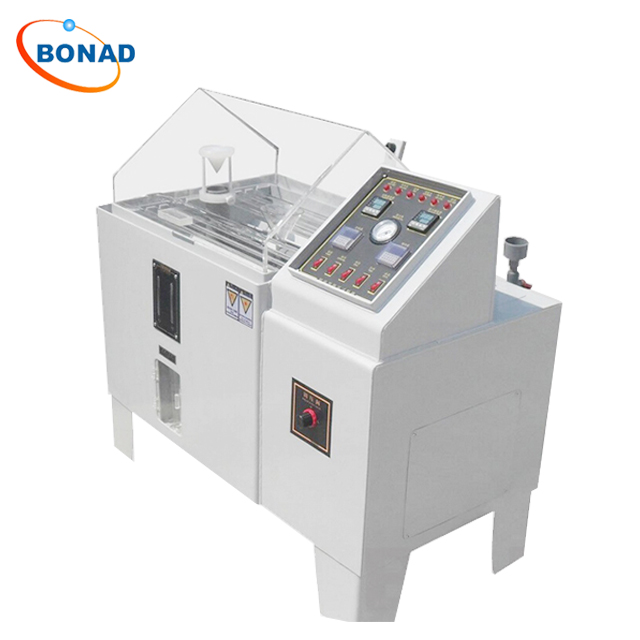What is a salt spray test?
Salt spray test is an environmental test that mainly uses artificial simulated salt spray environment conditions created by salt spray test equipment to evaluate the corrosion resistance of products or metal materials.
Salt spray corrosion mechanism
Corrosion is the destruction or deterioration of materials or their properties under the influence of the environment. Most corrosion occurs in the atmospheric environment, which contains corrosive components and factors such as oxygen, humidity, temperature changes and pollutants. Salt spray corrosion is a common and most destructive one. The salt spray mentioned here refers to the chloride atmosphere, and its main corrosive component is the chloride salt in the ocean, which mainly comes from the ocean and inland saline-alkali areas. The corrosion of the surface of metal materials by salt spray is caused by the electrochemical reaction between the chloride ions contained in it penetrating the oxide layer and protective layer on the metal surface and the internal metal. At the same time, the chloride ions contain a certain hydration energy, which is easily adsorbed in the pores and cracks on the metal surface to squeeze out and replace the oxygen in the oxide layer, turning the insoluble oxide into a soluble chloride, and turning the passivated surface into an active surface. It causes extremely bad adverse reactions to the product.
Salt spray tests are divided into two categories: natural environment exposure tests and artificial accelerated simulated salt spray environment tests.
Artificial simulated salt spray environment test
Artificial simulated salt spray environment test is to use a salt spray test chamber with a certain volume to create a salt spray environment in its volume to test the salt spray corrosion resistance of the product. Compared with the natural environment, the salt concentration of chloride in the salt spray environment can be several or dozens of times that of the salt spray content in the general natural environment, which greatly increases the corrosion rate and greatly shortens the time to obtain the results of the salt spray test on the product.
Artificial simulated salt spray test classification:
1. Neutral salt spray test (NSS Test)
It is the earliest and most widely used accelerated corrosion test method. It uses a 5% sodium chloride salt solution with a pH value adjusted to a neutral range (6-7) as a spray solution. The test temperature is 35°C, and the salt spray deposition rate is required to be between 1 and 2 ml/80 cm2.h.
Neutral salt spray test is the most commonly used test method. If no special instructions are given, the salt spray test we are talking about usually refers to the neutral salt spray test.
2. Acetic acid salt spray test (ASS test)
The acetic acid salt spray test is developed on the basis of the neutral salt spray test. It is to add some glacial acetic acid to the 5% sodium chloride solution to reduce the pH value of the solution to about 3, the solution becomes acidic, and the salt spray formed finally changes from neutral salt spray to acidic. Its corrosion rate is about 3 times faster than that of the NSS test.
3. Copper salt accelerated acetic acid salt spray test (CASS test)
It is a recently developed rapid salt spray corrosion test. The test temperature is 50°C. A small amount of copper salt, copper chloride, is added to the salt solution to strongly induce corrosion. Its corrosion rate is about 8 times that of the NSS test.
4. Alternating salt spray test
It is a comprehensive salt spray test, which is actually a neutral salt spray test plus a constant humidity and heat test. It is mainly used for cavity-type complete products. Through the penetration of the humid environment, salt spray corrosion is not only generated on the surface of the product, but also inside the product. It alternately switches the product under salt spray and humidity and heat conditions, and finally evaluates whether the electrical and mechanical properties of the complete product have changed.
Salt spray test reference standard:
IEC 60068-2-11;IEC 60068-2-52;ISO 9227;ISO 4623;ISO 6270-2;ISO 16701;ASTM B 117; ASTM D1735;ASTM D2247;ASTM D2803;ASTM D5894;ASTM D6899;ASTM G85;
Salt spray test application areas:
- Road traffic: road vehicle electronic and electrical equipment, rail transit locomotive and vehicle equipment and devices, auto parts, etc.
- Computers: computers, display screens, host computers, computer components, medical equipment and other precision instruments, etc.
- Electronic communications: mobile phones, radio frequency devices, electronic communication components, etc., PCB, PCBA.
- Electrical appliances: home appliances, lamps, transformers and other home appliances, instruments and meters, medical equipment;
- Others: electroplating, coating, packaging boxes, transportation equipment, etc.
Salt spray test equipment – Salt spray test machine
Salt spray test is usually carried out by salt spray test machine. The working principle of salt spray test machine is to compress the air into spray, and then try to cover all surfaces of the sample with the spray. This test can be carried out continuously or cyclically until the sample shows the expected corrosion phenomenon. Then record the corrosion time to indicate the corrosion resistance of the sample.



